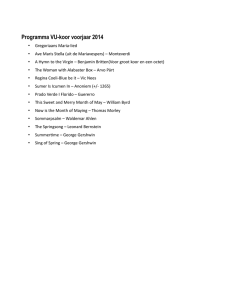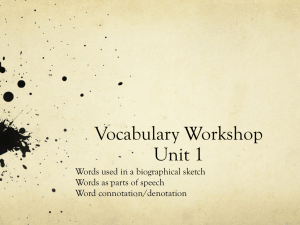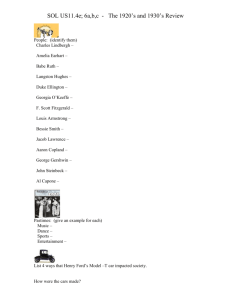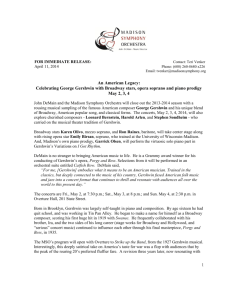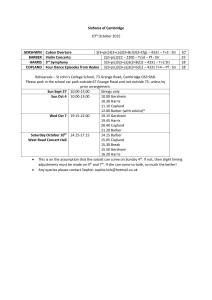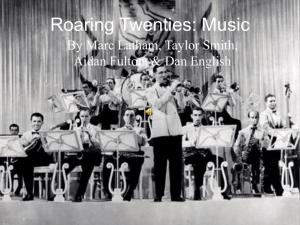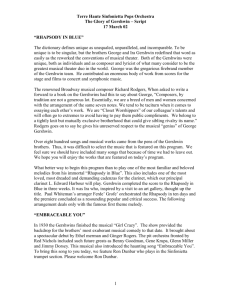A DECOMPOSITION METHOD FOR
advertisement
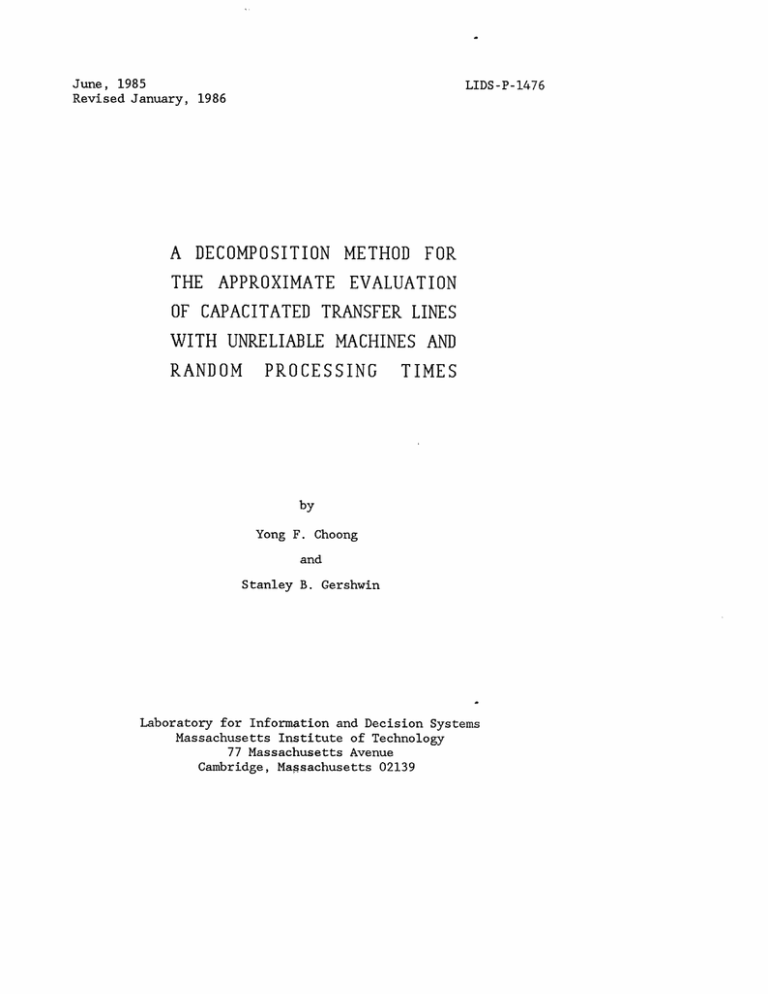
June, 1985
Revised January, 1986
LIDS-P-1476
A DECOMPOSITION METHOD FOR
THE APPROXIMATE EVALUATION
OF CAPACITATED TRANSFER LINES
WITH UNRELIABLE MACHINES AND
RANDOM
PROCESSING
TIMES
by
Yong F. Choong
and
Stanley B. Gershwin
Laboratory for Information and Decision Systems
Massachusetts Institute of Technology
77 Massachusetts Avenue
Cambridge, Massachusetts 02139
CHOONG and GERSHWIN
page 2
ABSTRACT
This paper presents a decomposition method to evaluate the
performance measures of a capacitated transfer line with unreliable machines and random processing times. The decomposition is
based on approximating the (k-l)-buffer system by k-l singlebuffer systems. Numerical examples indicate that the approach is
viable as long as the probability that a machine is starved and
blocked at the same time is small.
ACKNOWLEDGEMENTS
This research has been supported by the U. S. Army Human
Engineering Laboratory under contract DAAKll-82-K-0018. We are
grateful for the support and encouragement of Mr. Charles Shoemaker.
page 3
CHOONG and GERSHWIN
1. INTRODUCTION
This paper presents a decomposition method to evaluate
the performance of a capacitated transfer line with unreliable
machines and random processing times. The method follows that of
Gershwin (1983). It is based on a model which approximates a (kl)-buffer system by k-l single buffer systems. The parameters of
the single-buffer systems are determined by relationships among
the flows through the buffers of the original system. An iterative search algorithm is then developed to calculate the throughput rate and the average buffer levels.
Figure 1 depicts a transfer line with a series of k servers
machines (M1,M2,...,M k) separated by queues or buffers
(B 1 ,B 2 , ... , Bkl) '
The
buffers
are
each of
finite
storage capacity (C1,C2,..
,CkCk1)
Material flows from
or
outside the sytem to M1, then to B1, and through all
machines and buffers in sequence until it exits via M k.
the
Each machine spends a random amount of time processing each
item. The randomness of M i is characterized by three exponenthe service time (with mean
tially distributed random variables:
l/p&i), the time to fail (with mean 1/pi) and the time to
When machine M i is in a failure
repair (with mean l/ri).
condition or taking a relatively long time to process an item,
buffer Bi1 l tends to accumulate material and buffer B i
tends to lose material. If this condition persists, it will lead
of
of
machine
Mil1
and
starvation
to
blockage
it
has
finished
a
Mi_1 is blocked when
machine Mi+ 1
Mi+1
piece and finds that there is no place to tranfer it.
is starved when there is no piece for it to process.
The great dimensionality of the state space renders the
analysis of such system a formidable task. Each machine can be
operational or under- repair.
in one of two states:
Buffer B i can be in one of Ci+3 states: n i = O,1,...Ci,
Ci+l, Ci+2.
C i is the actual storage capacity of buffer
B i and n i is the level of material in transit between M i
It is convenient to define Ni=Ci+2 as an
and Mi+l
The disextended storage capacity between M i and Mi+1.
tinction is explained in Section 2.
As a consequence, the Markov chain representation of a kmachine line with k-l buffers has a state space of dimensionality
k-l
2k
J(C
1
i=1
+3).
page 4
CHOONG and GERSHWIN
A 20-machine line with 19 buffers each of storage capacity 8, for
example,
has
over
6.41x10 2 5
states.
1.1 Decomposition
As shown in Figure 2, the transfer line L is decomposed into
a set of two-machine lines L(i), i=l,... ,k. Their buffers have
the same capacities as those of L in Figure 1.
Pseudo-machine Mu(i) models the part of the line upstream
of Bi and Md(i) models the part of line downstream from B i.
We assume that the random behaviors governing flow into and out
of Bi can be characterized by six exponentially distributed
random variables with parameters: .u(i), pu(i), ru(i); and pd(i),
pd(i) and rd(i), respectively.
The key to the decomposition
method is to find these parameters so that the material flow into
and out of the buffers of the two-machine lines closely matches
the flow into and out of the corresponding buffers of the long
line L.
Six equations per buffer, or 6(k-1) conditions are required
to determine the parameters.
1.2 Literature Survey
The transfer line model analyzed here is an extension of
Related
Gershwin and Berman's (1981) two stage line model.
literature on the modeling and analysis of transfer lines is
documented in that paper.
The concept of approximate decomposition of transfer lines
was discussed by Hunt (1956), Hillier and Boling (1956), Takahashi et al. (1980), Altiok (1982, 1984), Altiok and Stidham
(1983), Jafari (1984), Suri and Diehl (1983), Gershwin (1983),
and others. In all papers surveyed except Gershwin's, the numerical method tends to sweep the line from one end (generally the
upstream end) to the other. The symmetry of the line (as observed
by Muth (1979) and Ammar (1980) has not previously been exploited. In addition, the interrupted nature of both the arrival
and service processes in the decomposed line has not been considered.
A similar approach to ours was recently described by Sastry
(1985), who also presented an extensive literature survey.
CHOONG and GERSHWIN
page 5
1.3 Contribution of this paper
Gershwin's (1983) decomposition method applies to transfer
lines with constant, identical service times. This paper adapts
that method to transfer lines with random service times.
The
accuracy of this method is evaluated via numerical simulation.
1.4 Outline
Section 2 describes the assumption and model of the production lines.
Section 3 describes the derivation of the 6(k-1)
equations. Section 4 evaluates the accuracy of the decomposition
method. Conclusions and new research directions are discussed in
Section 5.
page 6
CHOONG and GERSHWIN
2. MODEL DESCRIPTION AND ASSUMPTIONS
The development here is an extension of the 2-machine line
model in Gershwin and Berman (1981). The storage and blockage
condition are explicitly defined in response to the comment
raised by Altiok and Stidham (1982).
2.1 Machine Operations
A machine can be in one of two states:
operational or
under repair.
The machine state is denoted by the binary
variable a as
i
(1, when M i is operational;
=0, when M i is under repair.
When a machine goes from state 1 to state 0, it is said to
fail .
A repair takes place when the transition from
a=O to a=l occurs.
When a machine is in state 1, it can
process workpieces only when it is not starved or blocked. It
processes no pieces when it is under repair. After the machine is
repaired, it resumes work on the same piece it was working on
when the failure occured.
It is assumed here that the first
machine is never starved and the last machine is never blocked.
Since blocked or starved machines are not processing, they
This assumption differs from
are not vulnerable to failure.
Wijngaard (1979), who allows failures of idle machines.
Service, failure and repair times for M i are assumed to
i', p., and
be exponential random variables with parameters
ri; i=l,...,k, the service rate, failure rate, and repair rate,
respectively. When a machine is under repair, it remains in that
state for a period of time which is exponentially distributed
This period is unaffected by the states of the
with mean l/r i.
other machine or of the storage.
When a machine is operational, it operates on a piece if it
is not starved or blocked. It continues operating until either
it finishes or a failure occurs, whichever happens first. Either
event can happen during the time interval (t,t+6t) with probability approximately yi6t or pit respectively, for small 6t.
The repair and workpiece completion models
those of Buzacott (1972). However, in Buzacott's
the probability of a failure before a completion
Here, instead,
of the time spent on the piece.
are similar to
failure model,
is independent
the longer an
page 7
CHOONG and GERSHWIN
operation takes, the more likely it is that a failure occurs
before the work is complete.
Buzacott's model would seem,
therefore, to be appropriate where the predominant cause of
failure is the transfer mechanism, clamping, or some other action
The model
that takes place exactly once during an operation.
presented here would seem to better represent failures in
mechanisms that are vulnerable during an entire operation.
2.2 Buffer State and Blockage Convention
The state of buffer Bi is denoted by the integer
This is the number of pieces in buffer Bi plus the piece
machine Mi+l.
When M i is blocked, n i also includes
finished piece in M i.
The storage capacity between M i
Mi+1 is denoted by Ci+l which includes one space
n i.
in
the
and
in
Mi+l
Machine Mi is blocked at the instant when it has completed
a piece and there is no storage space in B i. The convention for
Gershwin and Berman have used this same
blockage is ni=Ci+2.
convention in their mathematical formulation of a two-machine
line.
There, the blockage convention is (ni=Ni) where
This definition of blockage agrees with the one
Ni=Ci+2.
proposed by Altiok and Stidham.
Machine M i is starved at the instant when it has completed
a piece and there is no piece in Bi.1
in
In the following, we use Ni to denote the storage capacity
between machines M i and Mi+1.
The state s of the continuous time Markov chain model of
the transfer line is denoted by
{nl,... ,nk-ll,xl.. ,,ak)
2.3 Performance Measures
The probability that machine M i is processing a workpiece
is termed the efficiency E i and is given by
E i - prob[a =l, ni-l>O,
hi<Ni].
The production rate (throughput
M i in parts per time unit, is
(1)
rate)
of
machine
page 8
CHOONG and GERSHWIN
Pi -i
(2)
Ei
The mean buffer level n i is defined as the average of
materials in transit between the machines M i and Mi+1. It
is given by
(3)
n i prob(s).
ni -S
Formulas for these and related quantities for two-machine
lines can be found in Gershwin and Berman (1981).
2.4 Characteristics of the transfer line.
Conservation
of
Flow
Since there is no creation nor destruction of workpieces,
the flow is conserved. That is
P - P
Flow
P2
Rate-Idle
...
Pk'
Time
(4)
Relationship
Define ei to be the isolated
M i. It is given by (Buzacott, 1967)
efficiency
of machine
ri
ei = r+
(5)
and it represents the fraction of time that M i is operational.
The isolated production rate, Pi is then given by
Pi
=-
i ei'
(6)
and it represents what the production rate of M i would be if it
The actual
were never impeded by other machines or buffers.
production rate Pi is less because of blocking and starvation.
The efficiency satisfies
Ei = e i prob[ ni-l>O and ni<N i ].
(7)
See Gershwin and Berman (1981), and Gershwin (1984).
The flow rate-idle time relations can be stated as
Pi
=
pi prob[ nil>O and ni<Ni ].
(8)
page 9
CHOONG and GERSHWIN
This follows from equation (1).
While it is possible for nil=O
and ni=N i simulThis corresponds to an event in
taneously, it is not likely.
which M i finishes a piece and finds that it is both blocked and
starved.
The probability of this event is small because such
states can only be reached from states in which ni_-1l and
ni=Ni-l by means of a transition in which
1.
Machine Mil is either under repair,
taking a long time to process a piece, and
2.
Machine M i completes an operation,
3.
Machine Mi+1 is either under repair,
taking a long time to process a piece.
starved,
or
blocked,
or
and
The production rate may therefore be approximated by
Pi = Pi (1 - prob[ nir
1
] - prob[ ni=N i ]).
(9)
However, if there is a great variation in efficiencies and
service rates among the machines, this assumption may not hold
and the method may break down. An example illustrates this in
Section 4.
CHOONG and GERSHWIN
page 10
3. CHARACTERISTICS OF THE DECOMPOSITION
For every buffer Bi, the states of the line upstream of
Bi are aggregated into two groups, represented by the up
A similar aggregation applies
and down states of Mu(i).
to the states of the line downstream of B i. The decomposition
method assumes that the transition between the up and down states
of MU(i) (Md(i)) can be characterized by three exponential
ru(i), and pu(i),
processes with the parameters p (i),
(pd(i),
rd(i),
and
pd(i)).
This
aggregation
is
not
exact.
It is adopted here to characterize the most important features of
the behavior of the transfer line in a simple approximate way.
In this section, we derive the equations for the unknown
quantities: p (i), ru(i), pu(i), pd(i), rd(i) and pd(i), i=l,...,k.
They are based on conservation of flow (4), the flow rate-idle
time relationship (9), and a set of equations (13), (14), (19),
(20) and (28) developed below.
We first define the up and
pseudo machines Mu(i) and Md(i).
Definitions
: Up
and
down
states
(1) Mj is
down and,
(2) Mh
up,
(3)
nh=0,
the
Down
With reference to Figure 3, Mu(i) is down if,
j <i:
is
of
all
h:
j<h<i;
for some
and
j<h<i.
Therefore the time interval when MU(i) is down is the
period when the flow into B i is interrupted due to an upstream
machine failure.
This is distinguished from the period during
flow
is
interrupted due to a slow upstream machine
which the
while the intermediate buffers are empty.
In that case, Mu(i)
is considered up.
An equivalent recursive definition is: MU(i) is down iff
(1) M i is
down, or
page 11
CHOONG and GERSHWIN
(2) nil=O
and
Mu(i-1)
(1) Mi
is
operational
(2) Mi
is
operational,
(1) Mi+ 1
(2)
Md(i)
is
ni+l=Ni+l
Md(i)
is
(1)
M+
i+<
(2)
Mi
is
under
ni_1 >O,
ni_l=0
down
or
but
Mu(i-l)
is
up.
iff
or
Md(i+l)
is
down.
iff
is
operational
is
Md(i+l)
and
repair,
and
up
down.
other states of the transfer line
Therefore Mu(i) is up iff
Mu(i) is up for all
upstream of buffer B i.
Similarly,
is
operational,
is
n i+Si+l,
<N
and
ni+l=Ni+l
or
but
up.
With the classification of the up and down states of the
pseudo-machines and the exponential assumption of the transition
u(i),
ru(i),
p (i),
between the states, the parameters
ldd(i),
rd(i) and p d(i) are the rates for
distributed processes. They have the meanings:
the
exponential
ru(i) t (rprobability that Mu(i) (Md(i)) goes from
down to up in (t,t+6t) for small 6t;
probability that Mu(i) (Md(i)) goes from
pU(i)
6t (pd(i) 6t)
:
4
up to down in (t,t+6t) for small St,
given that B i is not full (empty) at t;
probability that a piece flows into
(out of) B i in (t,t+6t) for small St
u(i) 6t (Ad(i)
M
t)
:
when Mu(i) (Md(i)) is up,
given that B i is not full (empty) at t.
3.1 Derivation of Equations
Now we are ready to derive the 6(k-1)
equations needed to
CHOONG and GERSHWIN
page 12
characterize the transfer line.
Interruption
of
Flow
The first two sets of equations are based on the flow interruption phenomenon caused by machine failures.
By definition,
p (i) 6t = prob[ MU(i) down at t+6t
M(i) up and ni<Ni at t ](10)
Substituting the definition of Mu(i) down, we have
(Mi
pu(i)6t = prob
down
at
t+St)
or
(ni-1 0 and Mu(i-l) down at t+6t)
Mu(i) up and ni<N i at t
Since {M i down) and {ni_ 1=0 and Mu(i-l) down)
mutually exclusive events, equation (11) can be written as
p (i) 6t =
prob[ M i down at t+6t
+ prob
are
Mu(i) up and ni<N i at t ]
ni -1= and Mu(i-l) down at t+t
MU(i) up and ni<N i at t
The first term is the probability that M i fails
while processing a workpiece; that is, pi6t.
(12)
in
(t, t+6t)
Using Bayes' relationship, the second term can be written as
(ni-1 -O and Mu(i-l) down at t+6t) and
rob {M(i)
up
and
ni<N i
at
1
t)
prob[ MU(i) up and ni<N i at t ]
The denominator is the efficiency of M,(i);
that is, Eu(i).
With the definition of Mu(i) up and the fact that the
events
{ni<Ni) and {ni=N i and Md(i) up) are mutually
exclusive, the numerator can be written as
CHOONG and GERSHWIN
[
page 13
(nil--0 and Mu(i-l) down at t+St) and
(ni_1>0 or {ni_ 1=0 and Mu(i-l) up) at t) and
prob
{Mi up and (ni<N i or {ni=N i and Md(i) up)) at t)
[
(ni-1=0 and MN(i-l) down at t+St) and
{ni_ 1>0 or (ni_-=0 and Mu(i-1) up) at t) and
- prob
(M i up and
(ni=N i and Md(i)
up) at t)
The second term is zero because:
(1) when M i is blocked, the
probability
of
transition from
(ni_1>0 )
to
(ni_ 1=0)
is zero; and (2) we have assumed that the probability of the
event
(nil=-O
and
ni=Ni)
is
zero.
The event
( M i up and (ni<N i or {ni=N i and Md(i) up))
is the event (Md(i-l) up).
Hence the numerator is just
the steady state transition probability of line L(i-l) into state
(0,0,1). This is the same as the steady state transition probability out of state (0,0,1) and this is only possible via the
"repair" of Mu(i-l). Thus the numerator is the probability
ru.(i-1) p(i-1;001)
6t,
where p(i-1;001) is the steady state probability that line L(i-l)
is in state (0,0,1).
Therefore the parameter p (i) is given by
(i)
p M) =
U
+ ru(i-l) p(i-l;OOl)
i
+
Eu(i)
(13)
(13)
In a similar manner, we obtain
Pd
( i
)
P+)i+l
+
rd(i+l) p(i+l;N10)
(14)
Here, p(i+l;N10) is the steady state probability that line L(i+l)
is in state (N,1,0) and Ed(i+l) is the efficiency of Md(i+l).
page 14
CHOONG and GERSHWIN
Flow
of
Resumption
This second pair of equations describes the recovery from
The derivation follows from that in Gershwin
machine failures.
(1983) for transfer lines with constant service times.
By definition,
ru(i) 6t = prob[ MU(i) up at t+6t
I Mu(i) down and ni<N i at t ].
(15)
Substituting the definition of Mu(i) up, we get
M i up and
ru(i) Et = probi
{ni-1 >0 or (ni-1 O and Mu(i-l) up)) at t+6tJ
|
. (16)
(Mu(i) down and ni<Ni at t)
Using the equivalent notation
(nil
1 >O or {ni-1O0 and Mu(i-l) up))
(17)
= NOT(ni_l=O and Mu(i-l) down),
and decomposing the conditioning event, equation (16)
written as
[{ni-=O
ru(i) 6t
=
prob
can be
and Mu(i-l) down and ni<Ni) at t
{Mi down or (nil-O and Mu(i-l) down)
and ni<Ni}) at t
prob
{(Mi
uP and NOT(ni- 1=0 and Mu(i-l) down) at t+St)}
{ni-_=0 and Mu(i-1) down and ni<N i) at t
[
complement of the event of the first
L factor in the first term
pr Mi up and NOT(ni_01
1
j
and Mu(i-l) down) at t+t}
{Mi down and ni<N i at t)
This decomposition is possible because {ni 1 0} and
{Mi down) are disjoint events. This is because M i cannot fail
when it is starved from processing and when it fails, it has to
We now evaluate the four
be processing one piece of material.
(18)
(18)
CHOONG and GERSHWIN
page 15
conditional probabilities in (18).
Using Bayes' rule, the first factor of the first term of
(18) can be written as
{ni 1d0 and Mu(i-l) down) and
prob
u
0
(Mi down- or (ni
1
and
M
(i-l) down))
and (ni<Ni) at t
prob[
(Mi down or (ni_1=0 and Mu(i-l) down) and ni<Ni}) at t ]
Noting that (M i down) and (ni_ 1=O)
are disjoint, the
numerator is the probability that line L(i-l) is in state
(0,0,1). This probability is p(i-1;001).
The denominator is the probability of the conditional event
of (15), that is probability of ({M(i) down and ni<Ni).
This probability can be calculated by using the relationship
ru(i) prob[ Mu(i) down and ni<N i ]
= p (i) prob [ Mu(i) up and ni<N i ],
as given by Gershwin and Berman.
Thus, the denominator is
p (i)
prob[ Mu(i) down and ni<N i ]
pu
E,(i)
(i)
Eu
Hence, the first factor of the first term of (18) is
p(i-l;001l)ru(i)
p (i) Eu(i)
_
-
Xi
Now the second factor of the first term of (18) is the
probability of the transition of Mu(i-l) being down to being up
in (t,t+6t); that is ru(i-1) 6t.
The first factor of the second term is just l-X i.
The second factor of the second term of (18) is the probability of M i been repaired in (t,t+6t); that is ri6t.
Therefore, equation (18) can now be written as
ru(i) = ru(i-1) X i + r i (1-Xi),
i=2
....
, k-l.
(19)
CHOONG and GERSHWIN
Equation (19)
and ru (i-l).
page 16
shows that ru(i)
is a convex combination of ri
A similiar analysis yields
rd(j)
rd(j+l) Yj + rj+l (l-Yj),
j=l,
..., k-2
(20)
where
_
p(j+l;N10) rd(j)
i
- pd(j)
Ed(j)
Conservation
of
Flow
The conservation of flow states that the production rates of
the decomposed two-machine lines, L(i) and the transfer line are
the same. Thus
P
= Pi
Flow
=
Pk = P(i) = Pu(i) = Pd(i),
Rate-Idle
Time
i=l,
...
,k-l.
(21)
Relationship
The flow rate-idle time relationship gives
Pi = ei Ai ( 1- prob[ ni-1 0 ] - prob[ ni=NNi
)
(22)
Since the buffers in the decomposed two-machine lines behave
similarly to the corresponding buffers in the transfer line, we
have
prob[ni_ 1 = 0] = ps(i-l)
(23)
prob[n
(24)
and
i
= Ni] = pb(i)
where p (i-l)
becomes
is the
probability the buffer in line L(i-l)
empty and pb(i)
is
the
probability
that
Mu(i)
is
blocked. These probabilities are calculated from the two-machine
line formulas in Gershwin and Berman.
Gershwin and Berman show that the flow rate-idle time
relationship for a two-machine line is
CHOONG and GERSHWIN
ed(i-1) (
page 17
Pd(i1)
-p(i-l)
Sa
(25)
(i-1 )
and
eu(i)
( 1-pb(i))
P(i)
*
(26)
Using these relationships and the conservation of flow, (22) can
be written as
p
ei1 Hi
edil
P =ea
d
Boundary
d
(i-1)
il
+
+ e(i)
1
11
i=2 ,...,k-l. (27)
Conditions
The remaining 6 equations are satisfied by the boundary
conditions
ru(1)
=
p(1)
rd(k-l) =
r1
P1
rk
(28)
pd(k-1) = pk
Pd(k- 1) = Ak
Sastry's (1985) method is quite similar to this one.
The
principal difference is that Sastry propogates the mean times to
fail (1/p and l/pd) instead of the failure rates in the
interruption of flow equations; and the mean times to repair
(l/ru and 1/rd) instead of the repair rates in the resumption
of flow equations.
3.2 Numerical Technique
(19),
There are a total of 6(k-1) equations among (13), (14),
(20), (21), (27) and (28) in 6(k-1) unknowns:
rU(i),
Pu(i), Hu(i), rd(i), Pd(i),
ad(i); i=l,
..., k-1.
The equations can be thought of as defining a two-point
boundary value problem of the form
f(xi,xi+l) = 0;
i=l,
.., k-l.
where x i is a 6-vector of the parameters of the line L(i).
(29)
The
CHOONG and GERSHWIN
page 18
nonlinear function f(-,.) involves the evaluation of P(i),
p(i;N1O) and p(i;001) by means of the two-machine-line formulas
in Gershwin and Berman.
We have developed an algorithm similar to that of Gershwin
(1983).
It makes use of the two-point boundary value problem
structure, and works by iteratively evaluating the two-machine
lines. This algorithm is used to analyze several transfer lines
in the next section.
page 19
CHOONG and GERSHWIN
4. NUMERICAL RESULTS AND DISCUSSION
In this section, we report on numerical experience with the
We examined a variety of transfer lines, and we
algorithm.
compared decomposition and simulation results. Simulations were
all run for at least 100,000 time units.
4.1 Short Lines
line.
We used the decomposition method to analyze a three-machine
The only varying parameter is ,2'which in turn causes
P2, the isolated production rate of M2, to vary.
parameters are chosen to make the line symmetric.
When P2 is
small, M 2 is the bottleneck;
The other
the production
rate of the line is slightly less than P2 ' As P2
to infinity, the upper bound is given by the production
two-machine line with the parameters of M 1 and M 3
buffer capacity equal to C1+C2 plus the one storage
M2 . This upper bound is .258 parts per time unit.
increases
rate of a
and with
space in
The results are in Table 2. Figure 4 shows the variation of
production rate with P2. At the lower end, both the decomposition method and the simulation agree very well in terms of produThis agreement breaks down
ction rate and mean buffer levels.
The
when P2 exceeds 0.48 (about 1.5 times p1 or p 3 ).
production rate from the simulation approaches the upper bound
while that of the decomposition method exceeds this bound.
We believe the error in the decomposition method is due, in
part, to the non-negligible probability of the joint event
The last column
{nl70 and n 2=N2 ) when P2 exceeds 0.48.
in Table 2 shows, from numerical simulation, that the fraction of
time M 2 is simultaneously starved and blocked increases with P2 '
4.2 Longer Lines
Tables 3-9 list the results of the decomposition method on
The parameters of the machines are chosen to
longer lines.
represent a typical range of variation of a transfer line. The
efficiencies are between 85% and 95% and the isolated production
rates vary from 0.18-1.28 pieces per time unit. The mean processing times in Tables 3 and 9 are about an order of magnitude
larger that the mean repair times. The mean processing times in
Tables 4-8 are on the same order as the mean repair times.
CHOONG and GERSHWIN
page 20
The results indicate the accuracy of the decomposition
method in these cases. Typical errors in the throughput rate are
less than 5%. The error does not seem to be sensitive to the
length of the line.
4.3 Algorithm Behavior
When the algorithm converges, it often converges rapidly.
For example, the three-machine case of Table 1 in which A2 = .5
converged after 30 evaluations of the two-machine line, and the
five machine case of Table 4 converged after 134 evaluations.
The eight-machine cases of Tables 8 and 9 converged after 345 and
882 iterations, respectively. These evaluations are very rapid;
they are the analytic formulas of Gershwin and Berman (1981).
There were many cases in which this algorithm failed to
converge. By comparison, the very similar algorithm of Gershwin
(1983) is quite stable. We conjecture that the difference is due
to the Interruption of Flow equations ((13) and (14)). Further
evidence comes from other experiments (not reported elsewhere)
that were performed with the model of Gershwin (1983). The
algorithm for that model was modified so that the Resumption of
Flow equations were replaced by the Interruption of Flow equations. We were never able to make the modified algorithm converge.
4.4 Transfer Line Behavior
In Tables 10.1-10.4, a 4-machine line is used to show the
relationship between machine efficiency and speed. Tables 10.1
lists the parameters of the base case; Tables 10.2-10.4 show the
results as one parameter is v4ried at a time. The results suggest that machine efficiency contributes more to line production
rate than machine speed does.
CHOONG and GERSHWIN
page 21
5. CONCLUSIONS AND FURTHER RESEARCH
A decomposition method has been developed to analyze capacitated transfer lines with unreliable machines and random processing times. Numerical examples show that this method is accurate as
long as the probability that a machine is simultaneously starved
The accuracy of the algorithm does not
and blocked is small.
seem to be sensitive to the length of the line. However, it does
appear to be unstable and does not always converge.
Future research effort should be directed at incorporating
into the decomposition method the event that a machine can be
starved and blocked at the same time. An alternate effort is to
quantify the error bound of the method. The convergence properThis decomposition
ties of the algorithm should be studied.
method should be extended to more general networks such as
assembly/disassembly networks and Jackson-like networks with
blocking.
page 22
CHOONG and GERSHWIN
REFERENCES
T. Altiok (1982), Approximate Analysis of Exponential Tandem
Queues with Blocking, European Journal of Operations
Research, Vol. 11, 1982.
T. Altiok (1984), Approximate Analysis of Production Lines
with General Service and Repair Times and with Finite Buffers,
Rutgers University Industrial Engineering Department, April,
1984.
T. Altiok and S. Stidham (1982), A Note on Transfer Lines with
Unreliable Machines, Random Processing Times, and Finite Buf2, 125-127, June 1982.
14, No.
fers, IIE Transactions, Vol.
T. Altiok and S. Stidham (1983), The Allocation of Interstage
Buffer Capacities in Production Lines, IIE Transactions,
Vol. 15, No. 4, pp 292-299, June 1982.
J. A. Buzacott (1972), The Effect of Station Breakdown and
Random Processing Times on the Capacity of Flow Lines with InProcess Storage, AIIE Transactions, Vol. 4, No. 4, 308-312.
M. H. Ammar (1980), Modeling and Analysis of Unreliable Manufacturing Assembly Networks with Finite Storages, MIT Laboratory for Information and Decision Systems Report LIDS-TH-1004.
S. B. Gershwin
the Approximate
rage Space and
Decision Systems
(1983), An Efficient Decomposition Method for
Evaluation of Tandem Queues with Finite StoBlocking, MIT Laboratory for Information and
Report LIDSP-P1309.
S. B. Gershwin (1984), An Efficient Decomposition Method for the
Approximate Evaluation of Production Lines with Finite Storage
Space, in Analysis and Optimization of Systems, Proceedings
of the Sixth International Conference on Analysis and Optimi
zation of Systems, Part 2, Volume 63 of Lecture Notes in
Control and Information Sciences, Springer-Verlag, 1984.
S. B. Gershwin and 0. Berian (1981), Analysis of Transfer
Lines Consisting of Two Unreliable Machines with Random Processing Times and Finite Storage Buffers, AIIE Transactions
Vol. 13, No. 1, March 1981.
CHOONG and GERSHWIN
page 23
F. S. Hillier and R. Boling (1977), Toward Characterizing the
Optimal Allocation of Work in Production Lines with Variable
Operation Times, in Advances in Operation Research, Proceedings of EURO II, Marc Reubens, Editor; North-Holland, Amsterdam.
G.
C.
Hunt (1956), Sequential Arrays of Waiting Lines,
Operations Research, Vol. 4, 1956.
M. A. Jafari (1984), Modeling of Automatic Transfer Lines with
Possible Scrapping of Units, Ph. D. Thesis, Department of
Industrial Engineering and Operations Research, Syracuse University.
E. J. Muth (1979), The Reversibility Property of Production
Lines, Management Science, Vol. 25, No. 2.
B. L. N. Sastry (1985), Analysis of Two-Machine Markovian
Production Lines and Decomposition of Longer Lines, Ph.D.
Thesis, Department of Mechanical Engineering, Indian Institute of
Technology, Bombay, India.
R. Suri and G. Diehl (1983), A Variable Buffer-Size Model and
its Use in Analyzing Closed Queuing Networks with Blocking,
Harvard University, Division of Applied Sciences, Sept., 1983.
Y. Takahashi, H. Miyahara, and T. Hasegawa (1980), An Approximation Method for Open Restricted Queuing Networks, Operations
Research, Vol. 28, No. 3, Part I, May-June 1980.
J. Wijngaard (1979), The Effect of Interstage Buffer Storage
on the Output of Two Unreliable Production Units in Series,
with different Production Rates, AIIE Transactions, Vol.
11, No. 1, 42-47.
CHOONG and GERSHWIN
i
page 24
Machine Parameters
ri
Pi
ei
Ai
N
Pi
1
.05 .03 .625 .5 .3125
2
.06 .04 .600
3
.05 .03 .625 .5 .3125
TABLE 1.
-
10
-
10
Parameters of the Transfer Line
Decomposition Method
2
0.1
0.2
0.3
0.4
0.5
0.6
0.7
0.8
0.9
1.0
1.2
1.5
1.6
2.5
3.0
2
0.06
0.12
0.18
0.24
0.30
0.36
0.42
0.48
0.54
0.60
0.72
0.90
0.96
1.50
1.80
P
nil
.060
.115
.159
.189
.209
.223
.231
.238
.243
.246
.252
.257
.258
.264
.266
9.618
8.836
7.872
6.957
6.203
5.623
5.180
4.841
4.577
4.365
4.052
3.744
3.669
3.275
3.151
2
0.382
1.164
2.128
3.043
3.796
4.376
4.820
5.159
5.423
5.635
5.948
6.256
6.331
6.725
6.849
Simulation
P
l
.060
.114
.159
.191
.210
.218
.230
.235
.239
.242
.245
.251
.249
.255
.253
9.618
8.961
7.792
7.012
6.174
5.711
5.250
4.961
4.811
4.468
4.294
4.091
3.902
3.692
3.613
n2
0.396
1.177
2.181
2.982
3.728
4.481
4.742
5.115
5.411
5.424
5.860
6.104
5.932
6.277
6.276
%M
2S
& B
0.00
-0.00
0.10
0.14
0.24
0.24
0.47
0.62
0.61
0.69
0.75
0.92
0.90
1.08
1.29
%M2 S &B : PERCENTAGE OF TIME M2 IS STARVED
AND BLOCKED CONCURRENTLY.
TABLE 2. RESULTS FROM THE DECOMPOSITION METHOD AND SIMULATION
CHOONG and GERSHWIN
page 25
i
Machine Parameters
ri
Pi
ei
Hi
N
Pi
1
.3 .02 .9375 1.
.9375
6
2
.5 .05 .9091 1.3 1.1818
4
3
.1 .01 .9091 1.5 1.3636
6
4
.4 .08 .8333 1.6 1.333
P
l
fi2
i3
Decomposition.78392.84791.46971.6013
Simulation
% Error
TABLE 3.
.78732.75041.42911.5564
-.43
3.5
2.8
2.9
Example of a 4-Machine Line
CHOONG and GERSHWIN
page 26
i
Machine Parameters
Pi
ei
i
Pi
N
1
2
.1 .01 .909 .25 .2273
.3 .02 .938 .20 .1875
4
4
3
.5 .04 .926 .30 .2778
4
4
5
.5 .02 .939 .20 .1875
.5 .04 .926 .30 .2778
4
ri
ni2
n03
n4
2.6571
1.6488
1.9740
.9243
P Dn
Decomposition 0.1377
Simulation
0.1439
2.7033
1.6285
2.0016
.9816
% Error
-4.31
-1.71
1.25
-1.38
-5.84
TABLE 4.
First Example of a 5-Machine Line
-
CHOONG and GERSHWIN
i
page 27
Machine Parameters
r i Pi
ei
Hi
N
Pi
1
2
.3 .02 .9375 .20 .1875
.4 .05 .8889 .23 .2044
4
4
3
.1 .01 .9091 .30 .2727
4
4
5
.4 .07 .8511 .26 .2213
.3 .02 .9375 .21 .1969
4
P
fil1
f2
fin3 14
Decomposition 0.1385 2.2318 1.6804 1.9433 1.6307
Simulation
0.1407
2.1883
% Error
-1.56
1.99
TABLE 5.
1.6565 1.9601 1.7058
1.44
-.86
-4.40
Second Example of a 5-Machine Line
CHOONG and GERSHWIN
page 28
i
N
1
Machine Parameters
r i Pi
ei
/i
Pi
.3 .02 .9375 .20 .1875
2
.4 .05 .8889 .23 .2044
4
3
4
5
6
7
.1
.4
.3
.1
.4
.2727
.2213
.1909
.2077
.2261
6
4
4
6
-
fi3
4
.01
.07
.03
.03
.06
fI
P
.9091
.8511
.9091
.7692
.8696
.30
.26
.21
.27
.26
2
fi5
n6
Decomposition 0.1333 2.3460 1.9121 3.8464 2.4237 1.6054 1.4906
Simulation
% Error
0.1304 2.3596 1.9789 3.7193 2.3258 1.5908 1.3502
2.22
TABLE 6.
-.58
-3.38
3.42
4.21
0.92
First Example of a 7-Machine Line
10.40
CHOONG and GERSHWIN
page 29
i
Machine Parameters
ri
Pi
ei
iL
1
.3 .02 .9375 .20 .1875
2
3
4
5
6
7
.4
.1
.4
.3
.5
.1
P
.05
.01
.07
.02
.06
.01
fi
.8889
.9091
.8511
.9375
.8929
.9091
nfi2
.23
.30
.26
.21
.23
.27
N
Pi
.2044
.2727
.2213
.1909
.2054
.2455
3
5
4
4
5
f4'
f5
6
Decomposition 0.1356 2.2984 1.8243 2.9069 2.2105 1.6129 1.1853
Simulation
% Error
0.1371 2.2761 1.8173 2.9493 2.1293 1.5856 1.1916
-1.09
TABLE 7.
0.98
0.39
-1.44
3.81
1.72
Second Example of a 7-Machine Line
-0.53
CHOONG and GERSHWIN
page 30
i
Machine Parameters
ri
P
N
Pi
ei
1
2
.3 .02 .9375 .20 .1875
.5 .05 .9091 .23 .2091
4
4
3
4
5
6
.1
.4
.3
.1
4
4
4
4
4
7
8
P
.01
.07
.05
.01
.9091
.8511
.8571
.9091
.3 .02 .9375
.4 .05 .8889
1
n2
.30
.26
.40
.27
.20
.23
3
.2727
.2213
.3429
.2455
.1875
.2044
4
-
5
6
n7
DecompositionO.13762.25911.81832.10401.77342.45012.38311.4980
Simulation 0.13882.23921.81422.12741.70922.33252.30881.5273
% Error
-0.86 0.89
TABLE 8.
0.23
-1.10 3.76
5.04
3.22
First Example of an 8-Machine Line
-1.92
CHOONG and GERSHWIN
i
page 31
Machine Parameters
ri Pi
ei
Pi
N
Pi
1
2
.3 .03 .9091 1.5 1.3636
.5 .05 .9091 1.3 1.1818
6
5
3
4
5
6
.1
.4
.3
.1
6
4
6
4
7
7
8
P
.01
.06
.04
.01
2.0
1.6
2.0
1.7
.3 .02 .9375 1.2
.4 .05 .8889 1.6
fil
.9091
.8696
.8824
.9091
f2
1.8182
1.3914
1.7648
1.5455
1.1250
1.4222
f3
f4
-
fs
f6
f7
DecompositionO.83824.27202.40073.63991.96803.36532.19761.6642
Simulation 0.83044.29082.42853.60101.92793.28852.15911.5684
% Error
0.94
TABLE 9.
-0.44 -1.14 1.08
2.08
2.33
1.78
Second Example of an 8-Machine Line
6.11
CHOONG and GERSHWIN
page 32
i
Machine Parameters
ri
Pi
ei
Ai
Pi
1
.05
.05
.5
.6
.3
2
.05
.05
.5
.6
.3
3
.05
.05
.5
.6
.3
4
TABLE 10.1 Fixed Parameters of a Three Machine Line
rl
Pi
e1
pl
P
nf1
f2
5.00 10-9 1.00 0.3 .1668 2.526 1.474
0.03 0.01 0.75 0.4 .1612 2.517 1.483
0.05 0.05 0.50 0.6 .1561 2.510 1.490
0.01 0.03 0.25 1.2 .1432 2.515 1.485
TABLE 10.2 Effects of Variations of the
Parameters of the First Machine
CHOONG and GERSHWIN
r2
page 33
p
ee2
2
22
P2
l
2
5.00 10-9 1.00 0.3 .1687 2.459 1.548
0.03 0.01 0.75 0.4 .1616 2.494 1.523
0.05 0.05 0.50 0.6 .1561 2.510 1.490
0.01 0.03 0.25 1.2 .1378 2.508 1.361
TABLE 10.3 Effects of Variations of the
Parameters of the Second Machine
r3
p3
e3
P3
P
fi¾
i2
5.00 10-9 1.00 0.3 .1684 2.456 1.544
0.03 0.01 0.75 0.4 .1616 2.477 1.506
0.05 0.05 0.50 0.6 .1561 2.510 1.490
0.01 0.03 0.25 1.2 .1365 2.625 1.479
TABLE 10.4 Effects of Variations of the
Parameters of the Third Machine
CHOONG and GERSHWIN
page 34
Line L
MI
r 1P
81
M2
82
M3
83
M4
84
M5
85
M
N1
r2 P,,
2
N2
r 3 ,P 3
N3
r 4 ,p 4
N4
r 5 ,P 5
N5
r6 ,p 6
L-
tL
FIGURE 1:
M(1)
8B
Z,-.< ru(1),pu(l)
,"u(l)
N,
/L-5
/L4
LL3
P6
6
N6
/
M7
r7 ,P 7
jL-
TRANSFER LINE
Md(l)
Line L(1)
rd(1),Pd(l)
y.
(1)
Mu (2)
82
Md( 2 )
Line L(2)
ru(2),pu(2) N 2
"-(2)
rd(2),pq(2)
Fl(2
Mu(3)
83
Md(3)
Line L(3)
ru(3),p (3) N 3
ILU(3)
rd( 3 ),Pd( 3 )
P'd( 3 )
Mu(4)
B4
Md(4)
Line L(4)
r,(4),pu(4) N4
/Lu(4)
rd(4),Pd( 4 )
;d(4) MU(M)
5
Md(5)
Line L(5)
ru(5),pu (5)N
~u(5)
rd(5), Pd(5)
/d(5)
Mu.(6)
86
Md(6)
Line L(6)
ru(6),pu(6) N rd(6),Pd(6)
F 2uM6) M Td (6)
FIGURE 2:
DECOMPOSED TWO-MACHINE LINES
page 35
CHOONG and GERSHWIN
aEMPTY-
M 1
MEMPTY
UNDER
REPAIR
OPERATIONAL
j< i
FIGURE 3:
DEFINITION OF M (i)
u
DOWN
M
page 36
Cj
lx
_(.
II'I
cO
=:
0-
Ij
I
i
IQ,~
o
0C
_)C
0CL~L
1'
Fr_
i
C
6
_
C
6-
IV
L-
